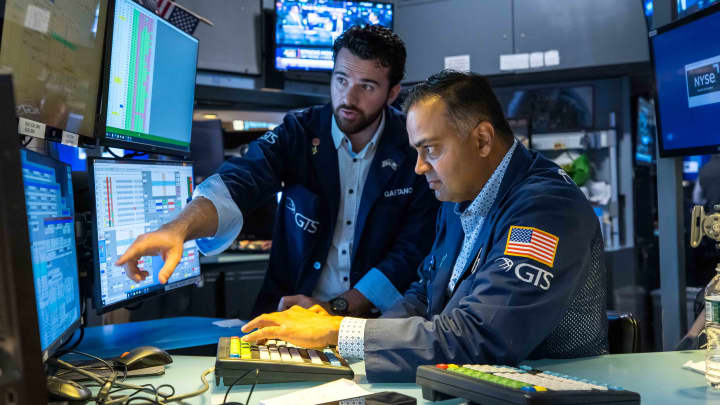
Stock futures ticked higher on Wednesday, with investors focusing on key second-quarter results from chipmaker to gauge whether the AI excitement is more than just hype.
climbed 0.5% while gained 0.7%. Futures tied to the was little changed.
All eyes on Wall Street were keenly awaiting Nvidia's second-quarter results after the closing bell, and it didn't disappoint. The company earned $2.70 per share after adjustments on $13.51 billion in revenue. That topped the average analyst estimate from Refinitiv of $2.09 per share in profits and $11.22 billion in revenue.
report in May had helped stoke investor interest in artificial intelligence, which became a key market driver in the first half of the year. Interest in the .
Nvidia once again raised its forecast, with executives predicting third-quarter revenue would climb to $16 billion, or an increase of 170% on an annual basis.
"The entire tech sector and overall market was waiting for Nvidia with this being the purest and best barometer for AI demand and the results/guidance were a 'drop the mic' moment in our opinion that will have a ripple impact for the tech space for the rest of the year," said Dan Ives, senior equity research analyst at Wedbush Securities.
Elsewhere, the broader field of semiconductor stocks were also trading higher in after hours trading. Shares of added 3.1%, while climbed nearly 4%. gained 5.4%.
Investors also await comments from Federal Reserve Chair Jerome Powell from Jackson Hole, Wyoming, on Friday, which Wall Street hopes will provide insight toward the path of benchmark interest rates.
shares fell about 3% in extended trading on Wednesday after the company said a manufacturing flaw would slow deliveries of its best-selling 737 Max.
Although won't impact safety, the company said it will need to conduct inspections to see how many airplanes are affected.
Boeing said it discovered fastener holes on the aft pressure bulkhead that "did not conform to our specifications."
Boeing shares have gained about 20% since the start of the year. The stock closed Wednesday about 6% below a 52-week high it hit at the beginning of the month.
—Christina Cheddar Berk
The percentage of financial newsletter editors and advisors who see short-term weakness ahead in stocks surged to 37.1% in the latest weekly survey, up from 32.9% last week. The reading is the highest since the fall of 2022, after which the S&P 500 went on to fall to 3600 from 4280, the survey said.
"This group is raising cash after recently calling for a trading top," II said. "The recent shifts want to lock in gains before they are gone." Just last month, the number of advisors foresseing a correction was the lowest since early January, "pointing to elevated risk and the need for defensive measures. This category looks for short term market weakness, and if declines continue their number could increase further. As cash is raised while markets fall, there is new fuel for the next rally," said II.
The number of bulls continued to shrink, falling to 44.3% from 47.1% last week and a July high of 57.1%, which nearly matched the Nov. 2021 peak of 57.2%. Bears dropped to 18.6% from 20.0% a week ago. The spread between the numbers of bulls and bears narrowed to 25.7 points from 27.1 last week and a two-year high of 38.5 reached in July.
— Scott Schnipper
Semiconductor stocks traded higher on Wednesday after Nvidia beat Wall Street expectations for second-quarter earnings.
Shares of AMD added 2.6% in extended trading, while peer Marvell Technology climbed nearly 4%. Taiwan Semiconductor was trading 2.3% higher. The broader added 2.4%.
Technology stocks also ticked up, with and adding 1.4% and 1%, respectively.
— Brian Evans
Stock futures were higher on Wednesday after another better-than-expected earnings report from chipmaker Nvidia roused Wall Street.
Futures tied to the added 33 points, or 0.1%. climbed 0.5% while gained 1%.
— Brian Evans




